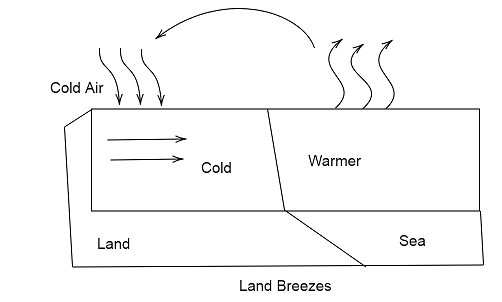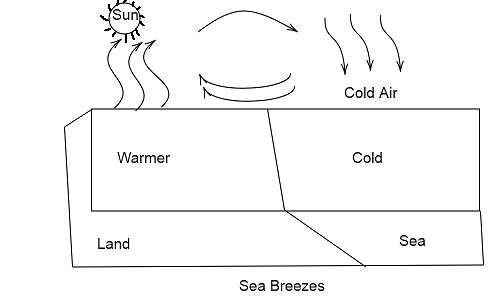
What are the land and sea breezes? Explain their formation.
Answer
449.7k+ views
Hint: We know here that the sea process takes place for the rest of the day. The sun heats both the sea and the surface of the earth. For the rest of the day, the reverse soil phase takes place. Then we draw the training diagram and explain how it was made.
Useful concept:
Concept of Land and sea formed is given below,
Due to differential heating and cooling of neighboring land and water surfaces, land and sea breezes create. Water has a higher potential for heat than soil.
The soil absorbs and releases radiation faster and more effectively.
Complete step by step solution:
Given by,
We describe land and sea breezes formation.
Land breeze
The land breeze is called the blowing of the breeze (air) from land to sea. Both land and seawater lose heat overnight. As opposed to marine water, the specific heat ability of the land is very low, the land loses heat energy quickly and cools faster than the sea. The seawater is higher, the air above it becomes thinner and rises. The air from the ground is under greater pressure. So, the air from the ground begins to blow towards the sea, giving rise to the Land Breeze.

Sea Breeze
During the day, the blowing of the wind (cold air) from sea to land is called the sea breeze. Both land and sea are heated equally by the sun during daytime, but the land has a very low specific heat capacity compared to the sea, it is heated up more rapidly. The air above ground thus becomes lighter and rises due to heat. As a result, pressure decreases, and cold and humid air above the sea begins to blow towards the shore, giving rise to the sea breeze.

Hence, the land breeze 's speed is slower than that of the sea breeze.
Note: Here, both of these breezes occur near massive bodies of water. While these take place at the same place, the air over the ocean is now colder than the air over the ground. This creates a slight temperature gradient at night between the ocean surface and the surrounding land, and the wind can blow from the land to the ocean, producing the land breeze.
Useful concept:
Concept of Land and sea formed is given below,
Due to differential heating and cooling of neighboring land and water surfaces, land and sea breezes create. Water has a higher potential for heat than soil.
The soil absorbs and releases radiation faster and more effectively.
Complete step by step solution:
Given by,
We describe land and sea breezes formation.
Land breeze
The land breeze is called the blowing of the breeze (air) from land to sea. Both land and seawater lose heat overnight. As opposed to marine water, the specific heat ability of the land is very low, the land loses heat energy quickly and cools faster than the sea. The seawater is higher, the air above it becomes thinner and rises. The air from the ground is under greater pressure. So, the air from the ground begins to blow towards the sea, giving rise to the Land Breeze.

Sea Breeze
During the day, the blowing of the wind (cold air) from sea to land is called the sea breeze. Both land and sea are heated equally by the sun during daytime, but the land has a very low specific heat capacity compared to the sea, it is heated up more rapidly. The air above ground thus becomes lighter and rises due to heat. As a result, pressure decreases, and cold and humid air above the sea begins to blow towards the shore, giving rise to the sea breeze.

Hence, the land breeze 's speed is slower than that of the sea breeze.
Note: Here, both of these breezes occur near massive bodies of water. While these take place at the same place, the air over the ocean is now colder than the air over the ground. This creates a slight temperature gradient at night between the ocean surface and the surrounding land, and the wind can blow from the land to the ocean, producing the land breeze.
Recently Updated Pages
Master Class 11 Economics: Engaging Questions & Answers for Success

Master Class 11 Business Studies: Engaging Questions & Answers for Success

Master Class 11 Accountancy: Engaging Questions & Answers for Success

Master Class 11 English: Engaging Questions & Answers for Success

Master Class 11 Computer Science: Engaging Questions & Answers for Success

Master Class 11 Maths: Engaging Questions & Answers for Success

Trending doubts
How is phenol converted to salicylic acid class 11 chemistry CBSE

Why was the Vernacular Press Act passed by British class 11 social science CBSE

Arrange Water ethanol and phenol in increasing order class 11 chemistry CBSE

Name the nuclear plant located in Uttar Pradesh class 11 social science CBSE

One Metric ton is equal to kg A 10000 B 1000 C 100 class 11 physics CBSE

What steps did the French revolutionaries take to create class 11 social science CBSE




